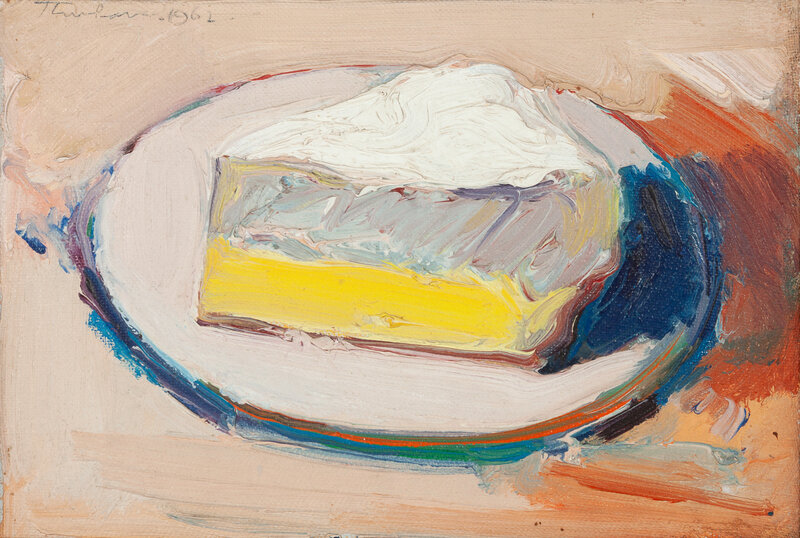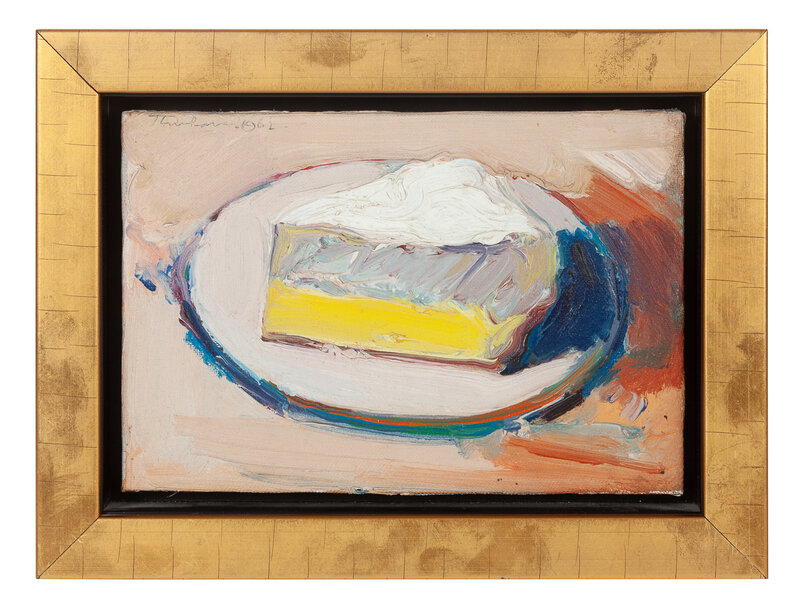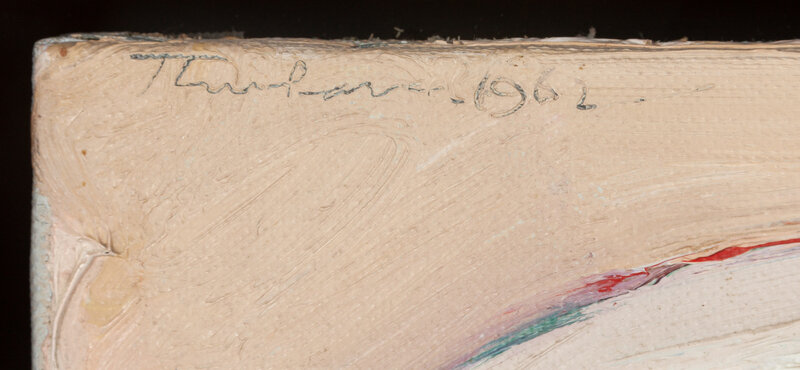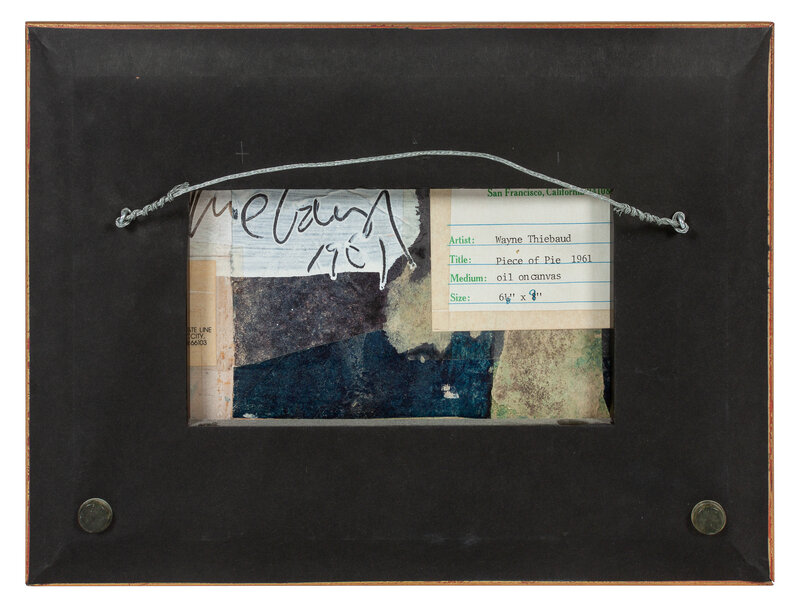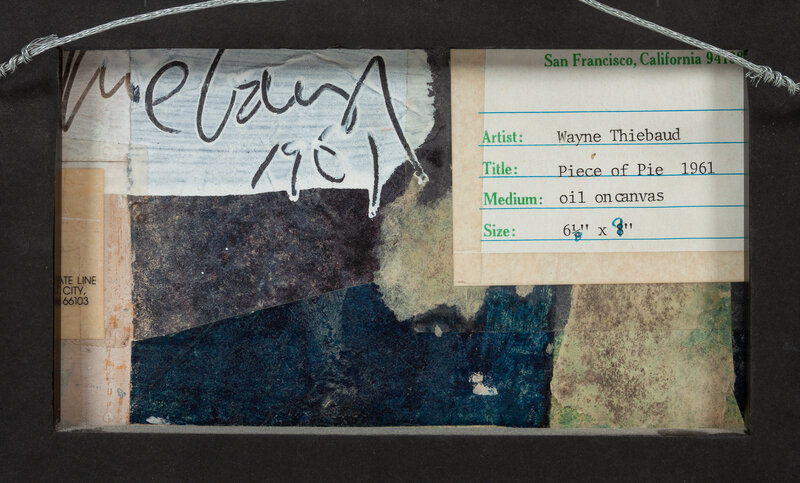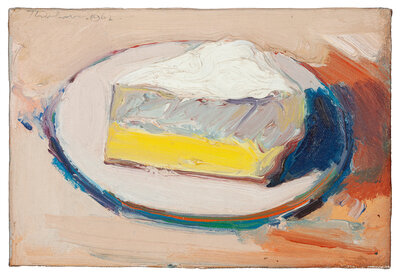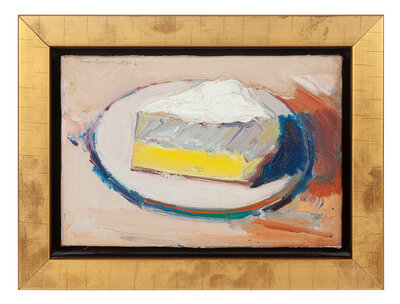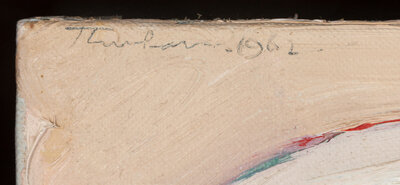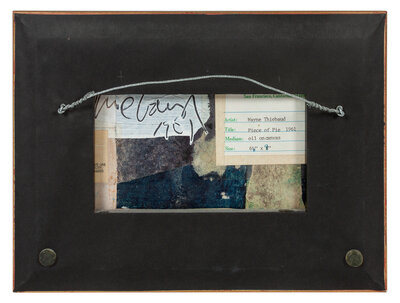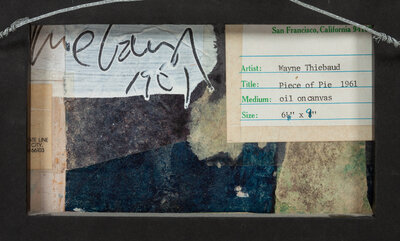Wayne Thiebaud
(American, 1920-2021)
Slice of Lemon Meringue Pie, 1961
Sale 2104 - Post War and Contemporary Art
Nov 14, 2024
10:00AM ET
Live / New York
Estimate
$600,000 -
800,000
Lot Description
Wayne Thiebaud
(American, 1920-2021)
Slice of Lemon Meringue Pie, 1961
oil on canvas
signed Thiebaud and dated (upper left)
6 1/8 x 9 inches.
Property from a Private Collection
Provenance:
John Berggruen Gallery, San Francisco
Jack Glenn Gallery, Corona del Mar, California
Douglas Drake Gallery, Kansas City, Missouri
Acquired directly from the above by the present owner in 1974
Lot Essay:
Though touching on a wide variety of quintessentially American subject matter throughout his career—landscapes and cityscapes of his local California, portraits, lipstick containers, and paint cans—most emblematic of the works by Wayne Thiebaud (1920-2021) are his still lifes of foodstuffs. Rows and rows of gleaming pies and cakes in diner cases, jewel-like gumballs, sumptuous taffy apples and ice creams, frozen on canvas right on the precipice of beginning to melt in the warm pastel light, Thiebaud was an expert at creating a vision of a food somehow more transcendent and temping than the real thing. Slice of Lemon Meringue Pie (1961) is no exception—an almost life-sized triangle of pie heightened through Thiebaud’s abstraction of form and creative use of color as well as through his distinctly American cultural sensibility towards pie.
Born in Arizona in 1920, Thiebaud was long interested in the art of American popular culture, working for a stint in Disney’s Animation department at 16, as a layout designer and cartoonist based in advertising, and as an exhibit designer for the California State Fair and Exposition’s annual art exhibition in Sacramento, while also working on his own practice. He began work as a teaching artist in 1951, shifting from Sacramento Junior College (now Sacramento City College) to the University of California, Davis in 1960, from which he received a grant to travel to New York in the summer of 1961, where he would mix with local artists who would influence him greatly—Franz Kline, Jasper Johns, the de Koonings, among others.
Based on his friendships with artists associated with the burgeoning Pop movement out east and his use of boldly colored quotidian objects plucked from mass culture, Thiebaud has often grouped among Pop artists. However, scholars have rejected this identification based on the difference in Thiebaud’s goals and stylization. While Pop artists were known for seeking to deemphasize the artist’s hand in the work—more closely aping the coldly unemotional mechanized sameness of mass-produced imagery often pulled from advertising, Thiebaud, while still using some of the same source material, emphasized his presence and opinion wherever possible.[i]
The artist’s hand is particularly apparent in Slice of Lemon Meringue Pie in the application of the meringue lovingly applied on top of the pie with the same whipped dollops of the original foodstuff, the texture carefully distinguished with the smooth lemon filling below. The variation of texture, along with the joyful use of color, elevates the abstracted triangles and circles into an understood plate of pie, where reds become crust and shadows pop with bursts of greens, blues, and orange. This use of color was critical to Thiebaud’s process. As he has said, for example, of pumpkin pie:
In my paintings of still-life, I was interested in the questions; how big is a piece of pie on a plate; what is the color of a pumpkin pie?... Well, pumpkin pie color is one color, damn it, and it is an ochre with some orange in it…When you place the mixture next to a slab of pumpkin pie, it seems to match in color but on canvas it definitely does not—why? It lacks life, vitality—one must add patches of orange, of blue, of other colors, in fact a mosaic of colors to give it some semblance of the pumpkin color on sees in reality.[ii]
In addition to Thiebaud’s exploration of color and form to portray his subjects, he also relied on a strong cultural consciousness of the subjects that he chose to depict, emphasizing imagery that was heavily embedded in contemporary American life, even if usually of themes that may have might be expected to be ignored “high” art. As described by cultural historian Sarah Kelly Oehler:
Although Thiebaud has cautioned against reading too much into his selection of subject matter, he has acknowledged that the foods he depicted had tremendous significance, both in his mind and in American society. For example, pie attracted him for its social resonance: “Pie has a long history and it has other implications: the idea of ‘Pie in the Sky,’ the old American preoccupation with Mom and Apple Pie.” But it also had a transformative presence: “One makes a pie out of ordinary stuff, like raisins, squash or apples and gift wraps it, in a sense, with a crust. It’s very magical, very special.”[iii]
Here, Thiebaud likewise is able to create something special, transforming abstract swipes of yellows and whites and purples into a slice of lemon meringue pie.
Bibliography:
Oehler, Sarah Kelly, “Convenience: Pop, Production, and the Making of Art in the 1960s.” In Art and Appetite: American Painting, Culture, and Cuisine, edited by Judith A. Barter. The Art Institute of Chicago, 2013.
Wilken, Karen. “An American Master.” In Wayne Thiebaud, edited by Kenneth Baker. Rizzoli, 2022.
[i] Karen Wilken, “An American Master,” in Wayne Thiebaud, ed. Kenneth Baker (Rizzoli, 2022), 13.
[ii] Art and Appetite: American Painting, Culture, and Cuisine
“Sarah Kelly Oehler, “Convenience: Pop, Production, and the Making of Art in the 1960s,” in Art and Appetite: American Painting, Culture, and Cuisine, ed. Judith A. Barter (The Art Institute of Chicago, 2013), 216.
[iii] Ibid., 216-217.
Condition Report
Auction Specialist
